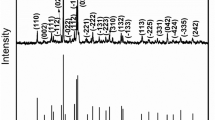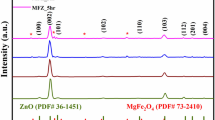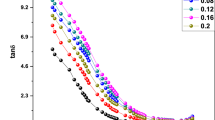Abstract
As a narrow band gap semiconductor, wurtzite β-CuGaO2 has drawn increasing attention in the area of solar energy. Although β-CuGaO2 has been theoretically predicted to possess ferroelectric polarization, its experimental ferroelectric characterization and practical applications have not yet been presented. Herein, firstly we experimentally confirmed its ferroelectric property via hysteresis loop measurement. The result showed a remanent polarization value of 10.20 μC·cm−2 with low coercive electric field of 6.45 kV·cm−1 at 20 Hz at room temperature, while the leakage current density (J) value was found to be 1.188 A·cm−2, which suggested the property of a larger remnant polarization with low coercive electric field than current value if the compactness was strengthened. Then, the synergistic effect of ferroelectric and semiconductor was comparatively highlighted by the experiment of pollutant degradation. Within 30 min, methyl orange degradation efficiency had reached 30.73% only in the case of spontaneous polarization (electricity), while it could reach 67.58% under the effect of pre-polarized β-CuGaO2 powder due to the modulating orientation of ferroelectric domains. Once irradiated (light), it was up to 92% within 30 min; in comparison, it merely took 16 min up to 92% degradation efficiency under both illumination and pre-polarization. If without illumination, it was 92.01% with 30 min in the condition of ordinary ultrasonic vibration (force) while under both illumination and ultrasonic vibration, only 11 min was spent to reach 92.79% degradation efficiency. All these results felicitously indicated that β-CuGaO2 had fascinating potential in energy harvesting (such as electricity, light, force) and transformation as wastewater environment remediation catalyst.
Graphical abstract

摘要
作为一种窄带隙半导体, 纤锌矿 β-CuGaO2已经在太阳能利用方面获得持续性关注. 尽管在理论上 β-CuGaO2被预测拥有铁电特性, 但是在实验上相关的表征与应用还没有被提出. 因此, 我们用P-E电滞回线的方法, 首次在实验上证实 β-CuGaO2的铁电性. 结果显示, 在室温20 Hz的测试频率下, β-CuGaO2的剩余极化值是10.20 μC·cm-2, 而对应的矫顽场仅为6.45 kV·cm-1. 但此时的漏电流 (J) 是1.188 A·cm-2, 这表明如果材料的致密度更高, β-CuGaO2可以获得比现在更大的剩余极化. 然后, 铁电体和半导体的协同效应通过有机物的降解实验进行比较研究。在30 min时, 仅在自发极化的条件下, 甲基橙 (MO) 的降解效率已经达到了30.73%。而当预先调节铁电畴取向 (预先极化 β-CuGaO2粉末) 时, 在30 min时, 降解效率已经达到了67.58%. 一旦光照, 降解效率在30 min内可达92%. 相比之下, 在光照和预极化条件下, 要达到92%的降解效率仅需16 min. 如果没有光照, 仅在超声的条件下, 降解效率在30 min内可以达到92.01%, 而同时在超声和光照作用下, 11 min即可达到92.79%的降解效率. 这些结果都很好地表明, β-CuGaO2在能量收集和转换方面有很好的应用前景, 比如作为污水环境修复的催化剂.






Similar content being viewed by others
References
Zhang Y, Zhao S, Su Q, Xu J. Visible light response ZnO-C3N4 thin film photocatalyst. Rare Met. 2021;40(1):96.
Liu X, Huang W, Zhou Q, Chen X, Yang K, Li D, Dionysiou DD. Ag-decorated 3D flower-like Bi2MoO6/rGO with boosted photo-catalytic performance for removal of organic pollutants. Rare Met. 2021;40(5):1086.
Ferraz NP, Nogueira AE, Marcos FCF, Machado VA, Rocca RR, Assaf EM, Asencios YJO. CeO2–Nb2O5 photocatalysts for degradation of organic pollutants in water. Rare Met. 2020;39(3):230.
Fujishima A, Honda K. Electrochemical photolysis of water at a semiconductor electrode. Nature. 1972;238(5358):37.
Bian Z, Tachikawa T, Zhang P, Fujitsuka M, Majima T. Au/TiO2 superstructure-based plasmonic photocatalysts exhibiting efficient charge separation and unprecedented activity. J Am Chem Soc. 2014;136(1):458.
Dumrongrojthanath P, Phuruangrat A, Thongtem S, Thongtem T. Photocatalysis of Cd-doped ZnO synthesized with precipitation method. Rare Met. 2021;40(3):537.
Zhou Y, Ouyang W, Wang Y, Wang H, Wu Z. Core-shell structured NH2-UiO-66@TiO2 photocatalyst for the degradation of toluene under visible light irradiation. Acta Phys Chim Sin. 2021;37(8):2009045
Chen Z, Wang D, Wang X, Yang J. Enhanced formaldehyde sensitivity of two-dimensional mesoporous SnO2 by nitrogen-doped grapheme quantum dots. Rare Met. 2021;40(6):1561.
Sarkar D, Ghost CK, Mukherjee S, Chattopadhyay KK. Three dimensional Ag2O/TiO2 Type II (p-n) nanoheterojunctions for superior photocatalytic activity. ACS Appl Mater Interfaces. 2013;5(2):331.
Yu X, Zhang J, Zhao Z, Guo W, Qiu J, Mou X, Li A, Claverie JP, Liu H. NiO-TiO2 p-n heterostructured nanocables bridged by zero-bandgap rGO for highly efficient photocatalytic water splitting. Nano Energy. 2015;16:207.
Linsebigler AL, Lu G, Yates JT. Photocatalysis on TiO2 surfaces: principles, mechanisms, and selected results. Chem Rev. 1995;95(3):735.
Scott JF. Applications of modern ferroelectrics. Science. 2007;315(5814):954.
Tu S, Guo Y, Zhang Y, Hu C, Zhang T, Ma T, Huang H. Piezocatalysis and piezo-photocatalysis: catalysts classification and modification strategy, reaction mechanism, and practical application. Adv Func Mater. 2020;30(48):2005158.
Rana DS, Kawayama I, Mavani K, Takahashi K, Murakami H, Tonouchi M. Understanding the nature of ultrafast polarization dynamics of ferroelectric memory in the multiferroic BiFeO3. Adv Mater. 2009;21(28):2881.
Huang H, Tu S, Zeng C, Zhang T, Reshak AH, Zhang Y. Macroscopic polarization enhancement promoting photo- and piezoelectric-induced charge separation and molecular oxygen activation. Angew Chem Int Ed. 2017;56(39):11860.
Feng Y, Li H, Ling L, Yan S, Pan D, Ge H, Li H, Bian Z. Enhanced photocatalytic degradation performance by fluid-induced piezoelectric field. Environ Sci Technol. 2018;52(14):7842.
Liu Y, Ye S, Xie H, Zhu J, Shi Q, Ta N, Chen R, Gao Y, An H, Nie W, Jing H, Fan F, Li C. Internal-field-enhanced charge separation in a single-domain ferroelectric PbTiO3 photocatalyst. Adv Mater. 2020;32(7):1906513.
Lee D, Baek SH, Kim TH, Yoon JG, Folkman CM, Eom CB, Noh TW. Polarity control of carrier injection at ferroelectric/metal interfaces for electrically switchable diode and photovoltaic effects. Phys Rev B. 2011;84(12):125305.
Omata T, Nagatani H, Suzuki I, Kita M, Yanagi H, Ohashi N. Wurtzite CuGaO2: a new direct and narrow band gap oxide semiconductor applicable as a solar cell absorber. J Am Chem Soc. 2014;136(9):3378.
Song S, Kim D, Jang HM, Yeo BC, Han SS, Kim CS, Scott JF. β-CuGaO2 as a strong candidate material for efficient ferroelectric photovoltaics. Chem Mater. 2017;29(17):7596.
Dudarev SL, Botton GA, Savrasov SY, Humphreys CJ, Sutton AP. Electron-energy-loss spectra and the structural stability of nickel oxide: an LSDA+ U study. Phys Rev B. 1998;57(3):1505.
Kresse G, Furthmüller J. Efficient iterative schemes for ab initio total-energy calculations using a plane-wave basis set. Phys Rev B. 1996;54(16):11169.
Blöchl PE. Projector augmented-wave method. Phys Rev B. 1994;50(24):17953.
Perdew JP, Burke K, Ernzerhof M. Generalized gradient approximation made simple. Phys Rev Lett. 1996;77(18):3865.
Setyawan W, Curtarolo S. High-throughput electric band structure calculations: challenges and tools. Comput Mater Sci. 2010;49(2):299.
Meng J, Liu X, Hao X, Zhang L, Yao F, Meng J, Zhang H. Microscopic mechanistic study on the multiferroic of R2CoMnO6/La2CoMnO6 (R = Ce, Pr, Nd, Pm, Sm, Gd, Tb, Dy, Ho, Er, Tm) by chemical and hydrostatic pressures: a first-principles calculation. Phys Chem Chem Phys. 2016;18(34):23613.
Zhou PX, Lu SH, Li CF, Zhong CG, Zhao ZY, Qu LH, Min Y, Dong ZC, Zhang N, Liu JM. Magnetism and hybrid improper ferroelectricity in LaMO3/YMO3 superlattices. Phys Chem Chem Phys. 2019;21(36):20132.
Song TK, Aggarwal S, Prakash AS, Yang B, Ramesh R. Activation field of ferroelectric (Pb, La) (Zr, Ti)O3 thin film capacitors. Appl Phys Lett. 1997;71(15):2211.
Su Y, Liu N, Weng GJ. A phase field study of frequency dependence and grain-size effects in nanocrystalline ferroelectric polycrystals. Acta Mater. 2015;87:293.
Zhang Q, Xia X, Wang J, Su Y. Effects of epitaxial strain, film thickness and electric-field frequency on the ferroelectric behavior of BaTiO3 nano films. Int J Solids Struct. 2018;144:32.
Liu J, Niu M, Wang L, Peng C, Xu D. Effect of tuning A/B substitutions on multiferroic characteristics of BiFeO3-based ternary system ceramics. J Magn Magn Mater. 2020;510:166928.
Kolb B, Kolpak AM. First-principles design and analysis of an efficient, Pb-free ferroelectric photovoltaic absorber derived from ZnSnO3. Chem Mater. 2015;27(17):5899.
Ederer C, Spaldin NA. Effect of epitaxial strain on the spontaneous polarization of thin film ferroelectrics. Phys Rev Lett. 2005;95(25):257601.
Liu W, Ren X. Large piezoelectric effect in Pb-free ceramics. Phys Rev Lett. 2009;103(25):257602.
Li F, Cabral MJ, Xu B, Cheng Z, Dickey EC, LeBeau JM, Wang J, Luo J, Taylor S, Hackenberger W, Bellaiche L, Xu Z, Chen LQ, Shrout TR, Zhang S. Gaint piezoelectricity of Sm-doped Pb(Mg1/3Nb2/3)O3-PbTiO3 single crystals. Science. 2019;364:264.
Wu J, Xu Q, Lin E, Yuan B, Qin N, Thatikonda SK, Bao D. Insights into the role of ferroelectric polarization in piezocatalysis of nanocrystalline BaTiO3. ACS Appl Mater Interfaces. 2018;10(21):17842.
Hill C, Weber MC, Lehmann J, Leinen T, Fiebig M, Kreisel J, Guennou M. Role of the ferroelastic strain in the optical absorption of BiVO4. APL Mater. 2020;8(8):081108.
Hao L, Huang H, Guo Y, Zhang Y. Multifunctional Bi2O2(OH)(NO3) nanosheets with 001 active exposing facets: efficient photocatalysis, dye-sensitization, and piezoelectric-catalysis. ACS Sustainable Chem Eng. 2018;6(2):1848.
Tan CF, Ong WL, Ho GW. Self-biased hybrid piezoelectric-photoelectro –chemical cell with photocatalytic functionalities. ACS Nano. 2015;9(7):7661.
Li Y, Wang W, Wang F, Di L, Yang S, Zhu S, Yao Y, Ma C, Dai B, Yu F. Enhanced photocatalytic degradation of organic dyes via defect-rich TiO2 prepared by dielectric barrier discharge plasma. Nanomaterials. 2019;9(5):720.
Xu S, Guo L, Sun Q, Wang ZL. Piezotronic effect enhanced plasmonic photocatalysis by AuNPs/BaTiO3 heterostructures. Adv Funct Mater. 2019;29(13):1808737.
Bai Y, Zhao J, Li Y, Lv Z, Lu K. Preparation and photocatalytic performance of TiO2/PbTiO3 fiber composite enhanced by external force induced piezoelectric field. J Am Ceram Soc. 2019;102(9):5415.
Liu Q, Liu ET, Li J, Qiu Y, Chen R. Rapid ultrasonic-microwave assisted synthesis of spindle- like Ag/ZnO nanostructures and their enhanced visible-light photocatalytic and antibacterial activities. Catal Today. 2020;339:391.
Chen F, Huang H, Guo L, Zhang Y, Ma T. The role of polarization in photocatalysis. Angew Chem Int Ed. 2019;58(30):10061.
Wang M, Wang B, Huang F, Lin Z. Enabling piezopotential in piezoelectric semiconductors for enhanced catalytic activities. Angew Chem Int Ed. 2019;58(23):7526.
Kalinin SV, Kim Y, Fong DD, Morozovska AN. Surface-screening mechanisms in ferroelectric thin films and their effect on polarization dynamics and domain structures. Rep Prog Phys. 2018;81(3):036502.
Starr MB, Shi J, Wang X. Piezopotential-driven redox reactions at the surface of piezoelectric materials. Angew Chem Int Ed. 2012;51(24):5962.
Ma T, Jacobs R, Booske J, Morgan D. Understanding the interplay of surface structure and work function in oxides: a case study on SrTiO3. APL Mater. 2020;8(7):071110.
Konstantiou IK, Albanis TA. TiO2-assisted photocatalytic degradation of AZO dyes in aqueous solution: kinetic and mechanistic investigations A review. Appl Catal B-Environ. 2004;49(1):1.
Chevalet J, Rouelle F, Gierst L, Lambert JP. Electrogeneration and some properties of the super oxide ion in aqueous solutions. J Electroanal Chem. 1972;39(1):201.
Song Y, Wagner BA, Lehmler H, Buettner GR. Semiquinone radicals from oxygenated polychlorinated biphenyls: electron paramagnetic resonance studies. Chem Res Toxicol. 2008;21(7):1359.
Zhu C, Wang L, Kong L, Yang X, Wang L, Zheng S, Chen F, Feng M, Zong H. Photocatalytic degradation of AZO dyes by supported TiO2 + UV in aqueous solution. Chemosphere. 2000;41(3):303.
Spadaro JT, Isabelle L, Renganathan V. Hydroxyl radical mediated degradation of AZO dyes: evidence for benzene generation. Environ Sci Technol. 1994;28(7):1389.
Vinodgopal K, Wynkoop DE, Kamat PV. Environmental photochemistry on semiconductor surfaces: photosensitized degradation of a textile AZO Dye, Acid Orange 7, on TiO2 particles using visible light. Environ Sci Technol. 1996;30(5):1660.
Tang Y, Hu C, Wang Y. Recent advances in mechanisms and kinetics of TiO2 photocatalysis. Prog Chem. 2002;14(3):192.
Acknowledgements
This work was financially supported by the Natural Foundation of Jilin Province (No. 190201106JC) and the Project for Science & Technology Development of Jilin Province (Nos. 20200602021ZP and 20200801048GH).
Author information
Authors and Affiliations
Corresponding authors
Ethics declarations
Conflict of interests
The authors declare that they have no conflict of interest.
Supplementary Information
Below is the link to the electronic supplementary material.
Rights and permissions
About this article
Cite this article
Yao, MC., Wu, XJ., Xu, LL. et al. β-CuGaO2: a ferroelectric semiconductor with narrow band gap as degradation catalyst for wastewater environmental remediation. Rare Met. 41, 972–981 (2022). https://doi.org/10.1007/s12598-021-01832-y
Received:
Revised:
Accepted:
Published:
Issue Date:
DOI: https://doi.org/10.1007/s12598-021-01832-y




